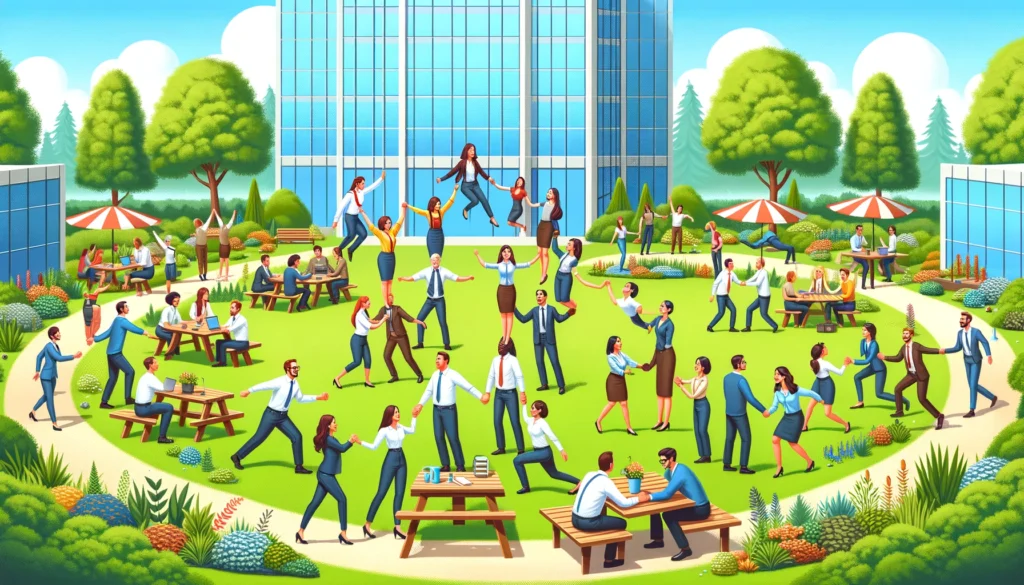
Picture this: You’re at work, and the day throws curveball after curveball at you. But instead of feeling overwhelmed, you handle each challenge with grace and efficiency. Sounds ideal, right?
This isn’t just a dream scenario—it can be your reality with the right tools and mindset. That’s where resilience comes into play, a skill that can turn workplace challenges into stepping stones for success.
But how do you build this invaluable skill, you ask? It all starts with a small first step, then daily actions that collectively create a resilient and positive work environment.
Imagine beginning your day with a team meeting that leaves everyone energized, receiving feedback that actually motivates you, and sharing moments of gratitude that uplift the entire team.
These aren’t just feel-good activities; they’re the building blocks of a robust, resilient workforce.
Join us as we guide you through 31 resilience in the workplace activities designed to strengthen your team’s resilience.
Whether you’re a team leader looking to inspire or an employee aiming to thrive, these team building activities are your stepping stones to a more resilient, fulfilling work life.
What is Resilience and its Importance in the Workplace
Resilience is our ability to bounce back from stress, challenges, and adversity. In the workplace, this means handling tough projects, changes in company structure, or everyday stresses with a positive attitude and a focus on solutions.
According to the American Psychological Association (APA) , resilience is not an innate quality but rather a set of behaviors, thoughts, and actions that can be developed over time. This perspective shifts resilience from being a personal trait to a dynamic process of learning and growth.
Resilience is significant at work because it helps teams and businesses overcome obstacles and thrive, even when things get tough.
For employees, building resilience can lead to several benefits. It reduces stress, as resilient individuals handle pressure more effectively.
It also increases job satisfaction; when employees feel capable of managing challenges, they’re more likely to enjoy their work. Importantly, resilience can significantly improve self-esteem.
When we overcome difficulties, it reinforces our belief in our abilities and our value to the team.
Advantages of Resilience Building Activities
For the organization, resilience-building activities can transform the workplace. They lead to higher productivity since resilient teams keep pushing forward, even under stress.
These activities also promote a happier, healthier work environment.
When employees know how to manage stress and bounce back from setbacks, there’s a more positive atmosphere all around.
Furthermore, a resilient workforce is more adaptable, quickly adjusting to changes and new challenges without losing momentum.
Implementing resilience activities like stress management training, team-building activities, and encouraging open communication channel, can help employees build this crucial skill.
These activities not only teach staff how to handle challenges but also bring both physical and remote teams closer, creating a supportive network that enhances collective and individual resilience.
Promoting resilience in the workplace is vital for both individual and organizational success.
It leads to more effective stress management, greater job satisfaction, and enhanced self-esteem for employees, while also contributing to higher productivity and a more adaptable, positive work environment for the organization.
Encouraging and developing resilience is not just about preventing burnout; it’s about creating a strong, supportive, and dynamic workplace where everyone can thrive.

31 Resilience in the Workplace Activities
Part 1: Setting a Positive Tone
1. Start with Positive Morning Meetings: Hold short, daily meetings where team members can share something positive, set their intentions for the day, and outline their main tasks.
This sets a constructive tone and encourages a positive mindset. This creates a supportive environment where everyone starts the day with a positive mindset.
Such meetings reinforce a sense of unity and purpose, and a good way to set a constructive tone for the day’s work.
2. Daily Gratitude Sharing: Encourage team members to share something they are grateful for each day.
It could be work-related, like a successful project completion, or personal, like a peaceful morning walk.
This practice shifts focus from stress and challenges to appreciation and positivity, which can enhance team spirit and positive thinking.
3. Constructive Feedback Rounds: Organize regular sessions where employees can give and receive constructive feedback.
This is an opportunity to commend good work, address areas for improvement, and discuss solutions collaboratively.
When done correctly, these feedback rounds or group discussions can significantly enhance work quality and strengthen relationships among team members.
This helps improve work quality and relationships, making the team stronger and more adaptable.
Part 2: Supporting Employee Well-being
4. Stress Management Workshops: Offer workshops on managing stress with techniques such as breathing exercises, meditation, or yoga, to help employees stay calm and focused even in difficult situations.
These practices can be incredibly beneficial in helping employees remain balanced and focused, especially when faced with stressful situations.
Teaching stress management can improve employee resilience and productivity.
5. Support for Mental Well-being: Promote the use of mental health days. It’s vital for employees to know they can take time off to recharge without stigma.
Additionally, provide access to resources such as counseling services or mental health apps.
Demonstrating that the company cares about their mental well-being can significantly enhance employee loyalty and job satisfaction.
6. Physical Health Programs: Create programs or challenges that encourage physical health, such as walking challenges or group sports, to improve physical well-being and energy levels.
Encouraging physical activity not only supports their health but also encourages team bonding and a sense of camaraderie outside the usual work tasks.
7. Healthy Eating Initiatives: Provide information on healthy eating and make healthy snacks available.
This support helps employees make better food choices, which can positively impact their energy levels and mental clarity throughout the workday.
8. Education on Sleep Hygiene: Share practical tips for improving sleep, such as maintaining a regular sleep schedule and creating a restful environment.
Highlight how quality sleep can significantly enhance their performance, mood, and general well-being.
Encouraging good sleep habits not only helps employees feel more rested and alert but also contributes to their long-term health and resilience.

Part 3: Encouraging Professional and Personal Growth
9. Professional Growth Opportunities: Allow employees to attend courses, seminars, or workshops that contribute to their professional growth, showing them that their development is valued.
Investing in their professional development not only enhances their skill set but also demonstrates your commitment to their career progression.
This can lead to increased job satisfaction, loyalty, and a more skilled workforce ready to take on new challenges.
10. Setting Personal and Professional Goals: Help employees set and track their personal and professional goals.
Guide them in setting both short-term objectives and long-term aspirations that align with their personal values and professional career path.
Offer regular check-ins to discuss progress and adjust goals as needed.
This process helps employees stay focused and motivated, giving them a clear sense of direction and purpose in their daily work and beyond.
11. Mentoring Programs: Pair up employees for mentoring, offering guidance and support.
This can facilitate a transfer of knowledge, promote a sense of belonging, and provide both parties with fresh perspectives and new learning opportunities.
Mentoring can be particularly effective for personal growth, as it allows employees to gain insights and advice from someone who has gone through similar paths.
This supportive relationship can enhance confidence, clarify career pathways, and enrich the professional experience for both the mentor and the mentee.
Part 4: Encouraging Mindfulness and Reflection
12. Regular Mindfulness Breaks: Encourage your employees to take short breaks specifically for mindfulness practices throughout the day.
This could be as simple as guided meditations, breathing exercises, or silent contemplation.
These breaks can significantly reduce stress, enhance concentration, and boost overall mental clarity.
13. Encouragement of Journaling: Promote the habit of journaling among your team members.
Encourage them to document their daily experiences, challenges they’ve faced, achievements, and reflections on personal growth.
This practice can greatly enhance self-awareness and problem-solving skills. This also encourages a deeper understanding of one’s thoughts and behaviors.
14. Relaxation and Quiet Zones: Create designated areas within the workplace where employees can find peace and quiet away from their desks.
These spaces should be dedicated to relaxation and free from work-related discussions and distractions.
This allow them the opportunity to recharge and decompress.
Whether it’s a few minutes of silence, meditating, or simply sitting quietly, having access to a dedicated safe space for relaxation can significantly improve overall well-being and productivity.

Part 5: Enhancing Team Cohesion and Communication
15. Team Bonding Retreats: Take the time to organize retreats or outings that are specifically designed to build stronger relationships among your team members.
Choose activities that encourage collaboration, trust, and open communication.
These could range from problem-solving exercises to more relaxed, social gatherings.
The goal is to break down barriers, improve mutual understanding, and create a more connected team.
16. Volunteering Together: Encourage your team to engage in volunteering activities together. This can be an great way to promote teamwork, while also giving back to the community.
Volunteering offers a unique context for team members to interact outside of their regular work roles, which can help break down formal hierarchies and improve interpersonal relationships.
Additionally, working towards a common cause can increase empathy, understanding, and respect among team members, contributing to a more cohesive unit.
17. Conflict Resolution Skills: Invest in training your team on effective conflict resolution techniques.
Misunderstandings and disagreements are natural, but the way they are handled can make all the difference.
Providing your team with the tools to resolve conflicts in a constructive manner can help maintain a positive work environment and the ability to work together effectively.
Training should focus on communication skills, empathy, and problem-solving strategies.
Part 6: Promoting Innovation and Problem Solving
18. Creative Problem-Solving Activities: Introduce activities that push your team to think outside the box and approach problems from new angles.
These can range from brainstorming sessions to complex simulation games. The aim is to challenge conventional thinking and encourage a fresh perspective on workplace issues.
When teams collaborate to overcome obstacles creatively, they not only find more efficient solutions but also improve their ability to adapt to new challenges and work together under pressure.
19. Allocated Creative Time: Dedicate specific times during the workweek for employees to explore creative projects that fall outside their regular responsibilities.
This could mean anything from researching new industry trends to developing a concept for a new product or service.
Allowing employees this creative freedom can lead to unexpected innovations that benefit the entire company.
Moreover, this scheduled creative time can act as a mental break from their routine tasks, recharging their minds and boosting overall job satisfaction.
20. Creation of Hobby Groups: Encourage the formation of hobby groups within your organization. These could be based on a variety of interests, such as photography, gardening, tech, or books.
When employees come together over shared interests, it strengthens their social bonds and promotes a sense of community and support within the workplace.
Also, these groups can act as a breeding ground for new ideas and perspectives, contributing to a more innovative and collaborative work environment.

Part 7: Recognizing Achievements and Learning from Setbacks
21. Regular Celebrations of Success: Make it a habit to recognize and celebrate both individual achievements and team milestones regularly.
This could be through simple gestures like shout-outs during meetings, or more formal recognitions such as awards or celebratory events.
Celebrating successes big and small reinforces positive behaviors and drives home the message that hard work is noticed and valued.
This boosts morale but also fuels the desire to continue performing well, encouraging an environment where striving for excellence is the norm.
22. Open Conversations About Failures: Create an environment where mistakes are openly discussed as learning opportunities, reducing fear of failure and encouraging a growth mindset.
Encourage your team to share their setbacks and the lessons learned from them in a non-judgmental setting.
This approach helps demystify failure, reducing the fear associated with it and allowing for a culture where experimentation and learning are encouraged
23. Sharing of Inspirational Stories: Introduce a platform where team members, or even guest speakers, can share their personal stories of overcoming challenges.
Hearing how others have faced adversity and emerged stronger can be incredibly motivating and enlightening for your team.
These stories can serve as powerful reminders that obstacles can be overcome and that resilience can lead to remarkable achievements.
Part 8: Creating an Adaptable and Supportive Work Environment
24. Meetings in Natural Settings: Whenever possible, hold meetings outdoors or in natural settings. Natural light and greenery can significantly boost mood, creativity, and overall well-being.
This change of scenery can lead to more relaxed, productive, and creative conversations compared to the traditional boardroom setting.
25. Installation of Positivity Boards: Create a space within the office where employees can post positive messages, affirmations, and success stories.
This could be a physical bulletin board or a digital platform, depending on your workspace dynamics.
Having a designated place to share and read positive content can significantly uplift the work atmosphere, making employees feel more supported and motivated.
This constant visual reminder of positivity helps reinforce a culture of optimism and encouragement.
26. Skill Exchange Workshops: Set up workshops or events where employees have the opportunity to teach each other skills that are not directly related to their everyday tasks.
This could range from cooking classes to coding workshops.
Not only does this allow employees to share their passions and talents, but it also promotes a sense of community and mutual respect.

Part 9: Building Comprehensive Support Systems
27. Resilience Skill Sessions: Provide resilience training sessions focused on building resilience skills, such as staying optimistic, managing emotions, and recovering from setbacks, to enhance mental toughness.
Equipping your team with the tools to withstand adversity, enhances their personal resilience, emotional intelligence and fortifies your organization against unforeseen challenges.
28. Establishment of Support Networks: Create systems or groups where employees can offer each other support, share experiences, and provide advice, building a supportive workplace community.
These could be formal mentorship programs or informal support groups based on shared experiences or challenges.
The goal is to create a sense of community where employees feel safe to express their concerns, share their experiences, and offer guidance to one another.
29. Resilience Resource Hub: Set up a library or online resource center with materials on building resilience and managing stress, providing tools for personal development.
This hub could include articles, videos, toolkits, and guides that employees can use to improve their coping strategies and personal development.
Having these resources readily available empowers your team to take proactive steps toward their mental well-being and personal growth.
30. Training in Time Management: Offer workshops on effectively managing time and priorities. Poor time management can be a significant source of stress and hinder productivity.
Offering training in this area, can help employees streamline their work processes, reduce stress, and achieve a better work-life balance.
Effective time management skills not only improve individual productivity but also contribute to a more efficient and harmonious workplace.
31. Flexible Working Options: Provide flexible working hours or the option to work from home.
Flexibility helps employees manage their personal responsibilities alongside their professional duties, reducing stress and enhancing job satisfaction.
Accommodating different work styles and life circumstances, demonstrates empathy and understanding, which can lead to increased loyalty and employee retention rates.

How Workplace Resilience Activities Enhance Self-Esteem
Resilience-building activities in the workplace play a significant role in enhancing employees’ self-esteem.
When teams start their day with positive morning meetings, it immediately boosts morale and makes individuals feel valued and part of a supportive community.
Constructive feedback rounds and regular acknowledgment of accomplishments allow employees to recognize their strengths and areas for improvement in a safe environment.
This kind of recognition and constructive critique helps build a positive self-image and confidence in one’s abilities.
Additionally, stress management workshops and resilience skill sessions equip employees with powerful tools to handle challenges effectively, reinforcing their belief in their own capabilities and contributing to a stronger sense of self-worth.
Engaging in team bonding activities, such as retreats or group projects, helps individuals feel connected and supported, which is essential for a positive work environment and individual self-esteem.
When employees feel part of a cohesive group, they are more likely to take risks and show vulnerability, knowing they have the support of their team.
This sense of belonging and acceptance is critical for personal growth and self-esteem.
Moreover, promoting physical health through organized wellness programs and encouraging mental well-being by providing support resources further contribute to employees feeling good about themselves, both physically and mentally.
Setting personal and professional goals, and providing opportunities for growth and learning, allow employees to pursue their aspirations and recognize their own progress and achievements.
Such initiatives make individuals feel competent and successful, key factors in boosting self-esteem.
Furthermore, creating a supportive culture where failures are viewed as learning opportunities encourages employees to step out of their comfort zones without fear of judgment, promoting resilience.
When employees are encouraged to reflect, learn, and grow from their experiences, they develop a healthier self-image and a more resilient outlook on work and life challenges.
Final Thoughts: The Transformative Power of Resilience in the Workplace Activities
We’ve gone through 31 activities designed to make your workplace better, not just more productive but a happier place too.
These different ways of building resilience in the workplace aren’t just random tasks; they’re important steps for building a place where everyone supports each other, grows together, and works well as a team.
The significance of these activities extends beyond mere exercises; they are essential tools in building an environment where support, growth, and collaboration are at the forefront.
Implementing these activities in your workplace can lead to remarkable changes. You’ll likely see people getting along better, talking more clearly and effectively, and feeling happier and more supported at work.
Expect to see a shift towards more positive interactions, an increase in effective communication, and a notable rise in the well-being of each team member.
These changes contribute to a resilient work culture where challenges and difficult circumstances are met with confidence and setbacks are viewed as opportunities for growth.
However, the journey doesn’t end here. The real magic happens when you keep using these activities and adjust them to fit what your team needs.
Now, it’s over to you. Try out these resilience activities in your workday and see the difference they make for you and your team.
And don’t keep it all to yourself—let us know how it goes! Whether you’ve tried out these activities at your job or found other great ways to bring your team together and make them stronger, we want to hear about it.
Your stories and experiences can help others and show them how to make their workplaces better too.
By talking about it, whether it’s in meetings, in a safe space, or with friends at work, you help everyone learn how to deal with the ups and downs of work life better.
Let’s all work together to create workplaces where everyone can do well and be happy.
For more amazing tips, subscribe at pheelpretty.com.
Love what you see? Share the love with friends and pin it to your Pinterest. Every share and pin means the world to us, helping us inspire more people. Subscribe and share now—let’s make positive changes together.
